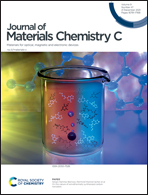Design and performance of an ultra-sensitive and super-stretchable hydrogel for artificial skin†
Abstract
Designing skin-comparable conductive hydrogels has attracted tremendous interest, while it remains challenging to simultaneously achieve super-extensibility and ultra-sensitivity. Herein, a novel hydrogel was successfully fabricated to tackle this problem by using acrylamide (AM), flowerlike micelles (polyethylene glycol dilaurate) and sodium chloride (NaCl) as the monomer, cross-linker and conductive filler, respectively. The synergy of micelle deformation under external loads and chain entanglement between polyethylene glycol and polyacrylamide chains endowed the gel with an ultra-stretchable property (elongation at break of 155 mm mm−1). Meanwhile, the dipole–dipole interactions between ions and polymeric chains led to an ultra-sensitive capacity (gauge factor = 54.5, tensile strain > 20 mm mm−1), superior to those of most hydrogel-based sensors. Therefore, the obtained sensor could precisely monitor various human motions, including finger bending at different angles, speaking, walking and running. Additionally, the presence of ions (Na+ and Cl−) endowed the gel with excellent anti-freezing properties (128 mm mm−1 tensile strain at −20 °C). This work sheds light on the fabrication of high-performance sensors and will broaden their applications.



 Please wait while we load your content...
Please wait while we load your content...